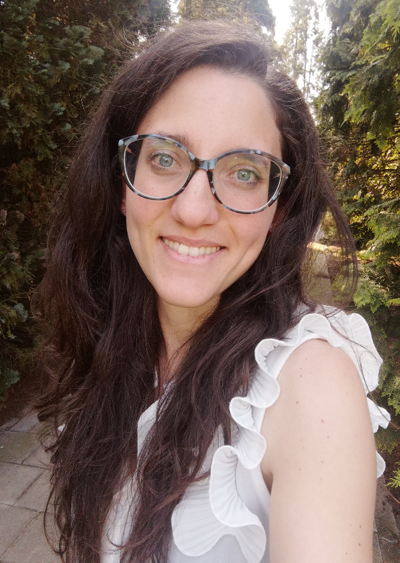integrated programmable waveguide circuits for classical and quantum photonic processing
Caterina Taballione is a PhD student in the Laser Physics and Nonlinear Optics group (LPNO). Her supervisors are prof.dr. K.J. Boller and prof.dr. P.W.H. Pinkse from the faculty of Science and Technology.
 Programmable waveguide circuits are crucial building blocks for integrated spectrometric applications and quantum photonic information processing. Amongst the dielectric material platforms in integrated photonics, silicon nitride stands out with highly attractive properties such as a large bandgap energy and a moderately high index contrast. This allows low propagation losses in a wide spectral range while simultaneously allowing a dense packing of components. The aforementioned properties, together with the inherent phase stability and phase programmability achievable in silicon nitride, enable the creation of complex photonic circuits. In this thesis we describe and demonstrate densely integrated programmable photonic circuits based on silicon nitride waveguides for wavelength metrology and quantum information processing.
Programmable waveguide circuits are crucial building blocks for integrated spectrometric applications and quantum photonic information processing. Amongst the dielectric material platforms in integrated photonics, silicon nitride stands out with highly attractive properties such as a large bandgap energy and a moderately high index contrast. This allows low propagation losses in a wide spectral range while simultaneously allowing a dense packing of components. The aforementioned properties, together with the inherent phase stability and phase programmability achievable in silicon nitride, enable the creation of complex photonic circuits. In this thesis we describe and demonstrate densely integrated programmable photonic circuits based on silicon nitride waveguides for wavelength metrology and quantum information processing.
A novel approach based on ring resonators and neural-network-based analysis is presented for realizing a high-precision integrated wavelength meter. A neural network is trained with a set of transmission spectra of an integrated photonic circuit consisting of ring resonators, either a single ring or two rings in vernier configuration, for various tuning settings of the integrated optical circuit. Subsequently, the transmission of an unknown input wavelength can be measured with the integrated optical circuit using the same settings as during the training. The unknown input wavelength is identified by a data-processing method finding the closest match between the calibrated transmission spectra and the measured one. We investigate various data-processing methods for maximizing the wavelength estimation range of the wavelength meter. We demonstrate long-term reproducibility and observe temperature immunity of the wavelength meter readout against changes of the ambient temperature.
We also present a reconfigurable multibeam interferometer, to be used as a photonic processor, containing 128 tunable elements in a Blass matrix configuration. This interferometer is the largest integrated programmable waveguide circuit realized so far in silicon nitride. We report a thorough characterization of the response of the tunable elements, i.e., their tuning range, the thermal crosstalk across the processor, the reproducibility, core response, dispersion and transparency of the processor. Due to fabrication imperfections, not all of the tunable elements can currently be set to the entire parameter range, which slightly limits the reconfigurability of the processor. Despite this fact, the processor holds a consistent reconfigurability over a wide spectral range of about 150 nm.
After the calibration of the tunable elements we inspect the possibility of optimizing the processor response, in spite of the finite tuning range of the tunable elements. We measure the fidelities of 100 unitary transformations sampled by a Haar random distribution and investigate whether the measured fidelities can be improved by optimizing the phase settings of the tunable elements over their constrained phase range. We demonstrate an optimization algorithm that is able to overcome, to a certain extent, fabrication imperfections for a majority of the implemented transformations.
We show that the aforementioned 8-modes circuit based on silicon nitride waveguides can be exploited as photonic processor for quantum information processing. We demonstrate a variety of photonic quantum information processing primitives such as Hong-Ou-Mandel interference, bosonic coalescence and anti-coalescence and high-dimensional single-photon quantum gates, exploiting the whole mode structure of the processor. We observe that the Blass matrix processor retains the indistinguishability of the photons and enables any arbitrary linear transformation, while fully programmable and remotely controllable as desired for quantum information processing. These results show the promising future of low-loss silicon nitride waveguides for large-scale photonic quantum information processing. Furthermore, due to its wide spectral range, silicon nitride allows interfacing with all common quantum light sources such as spontaneous parametric down-conversion sources and quantum dots.
Exploiting the long-term interferometric stability, low propagation loss and tight optical confinement of integrated silicon nitride waveguides, we have shown complex reconfigurable optical circuits both for classical spectral processing of light and quantum photonic processing. For future development of integrated programmable photonic processors, various challenges need to be addressed such as compact and low-power phase shifters, a further increase of the component density and lower propagation losses.





